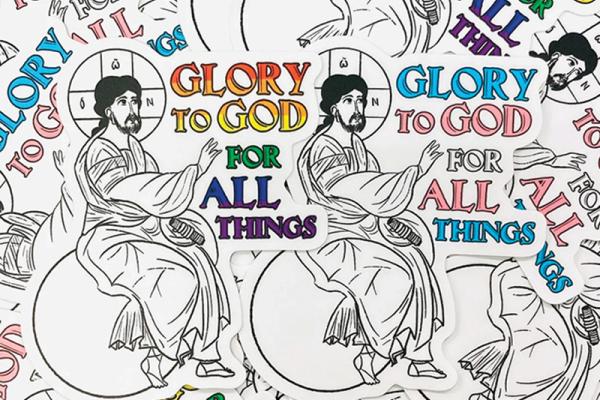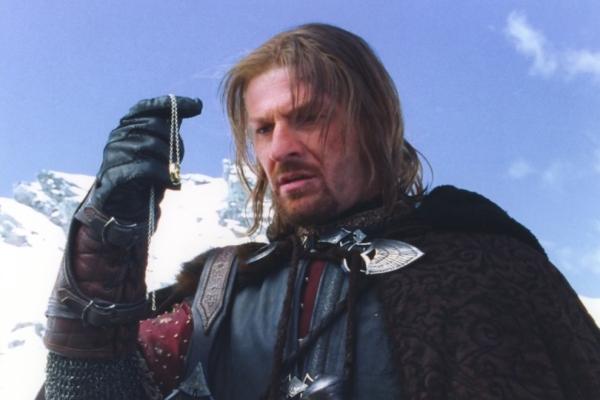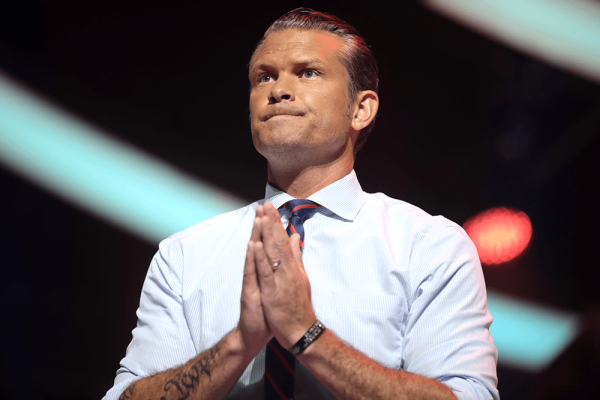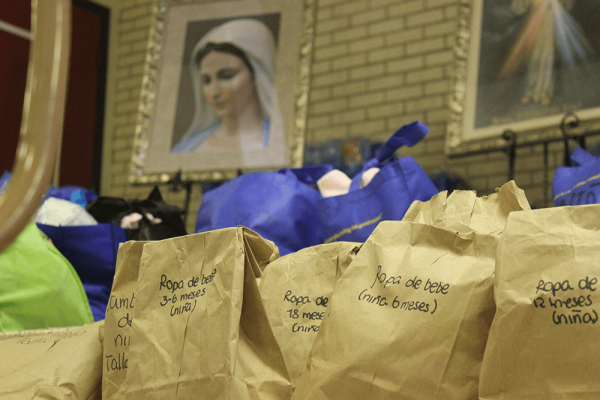ACCORDING TO AN Orthodox miracle story, St. Nicholas — the fourth century archbishop who inspired the figure of Santa Claus — quieted a raging sea. When sailors were caught in a storm on the Mediterranean, they called out for help. Nicholas appeared, walking on the waves before them. He blessed the ship, and the storm calmed. This is why he became the patron saint of sailors. It’s also why Mary Marza, a queer Orthodox artist in her mid-20s who is based in Los Angeles, illustrated St. Nicholas as a “waterbender.” Waterbenders, from the animated series Avatar: The Last Airbender, can control water and its movements. This is one of many works featured on her Instagram art account, Art of Marza.
“I liked the concept of blending saints with the elements or just blending the saints with things from my favorite stories and pop culture,” Marza wrote in an Instagram caption about this portrayal of St. Nicholas.
Marza (who asked to use her art account name instead of her real last name for this article) creates digital art and stickers that blend Orthodox iconography and prayer with street art and anime. The grungy, graffiti-and-animation-inspired aesthetic of her art and its confluence with iconography is part of her longing to “[see] God in places where people assume we can’t find Him,” she wrote on Instagram.
“Varză” in Romanian translates to “cabbage” in English, a word that Marza alludes to in her artist name. “In Romania, we have a saying that when you ruined something or made something into a big mess, you turned it into cabbage,” Marza said in an interview with Sojourners, explaining that she started Art of Marza in a very “difficult and chaotic” moment of her life. So “Marza” is a “nod to my heritage and also a nod to my mental state,” she explained.
Marza started making iconographic art and stickers in 2019. She was initially inspired by the landscape and street art of Los Angeles as well as some accounts she was following online, such as @after_icon_project, a collective of Russian artists “basically doing Orthodox graffiti, making icons on the sides of trains and buildings,” she said.
"I began to dabble with graffiti, just stickers and stuff because I don’t have the courage to [use] spray cans,” she said. “I started off drawing little icons on shipping labels and stickers and started slapping them around.”
One of Marza’s most popular stickers depicts a scene from the biblical story of the Good Samaritan: Against a neon background, she sketched a Christ-figure holding hands with a man lying on the ground. A caption hovers above them: “Refusing to harden your heart is a radical act.”
With her stickers, Marza wants to “combat the sadness that you see on the street.” While attending a queer Christian conference in Seattle, she saw a sticker on a freeway bridge that said, “Just jump.” “I got so mad,” she said. “I took my keys and started peeling that sticker off. This stuff has to be replaced with messages that give more hope, but that are also a call to action.”
The @after_icon_project Instagram account blocked her after she posted original art criticizing Russian Orthodox Patriarch Kirill and the war in Ukraine. “Which sucks, considering the work of those artists was such an inspiration to me,” Marza said.
In her illustration, Kirill, who is a supporter of both Russian President Vladimir Putin and the Ukraine invasion, holds a bloody sword; a Rolex watch wraps around his wrist. Red lettering flanks his face, reading, “Those who live by the sword shall die by the sword.” On the bloodstained medallion he is wearing, the Virgin and child are crying. “It is unbecoming of a man of God to use Christ and His mother’s name in vain for the sake of war,” Marza wrote in the Instagram caption. “All the Saints of Russia and Ukraine cry out.”
In another piece, the Theotokos (Mother of God) holds the Christ child in her right arm and grips a spear with her left hand. Assisted by the young hand of Jesus, Mary pierces the head of the golden stock market bull on Wall Street. Words from the Magnificat, in English letters that echo Russian letters in their shapes and design, surround her: “He hath put down the mighty from their seat, and hath exalted the humble. ... The rich He hath sent empty away.”
“I have been exhausted by the constant call to worship the false god of greed,” Marza wrote in the caption accompanying the art. “Trust in the economy has become the new trust in God.”
Icons remind us how to conduct our lives “outside of the confines of liturgy or the walls of a church,” Marza said. Her iconographic renderings of saints and prayers, produced in sticker form and stuck around cities, nod to her belief that “icons are windows to heaven [that] make me feel less alone in prayer,” she said. “It’s like having pictures of all your friends and family. The beauty of iconography makes for such a safe and cozy atmosphere, like I’m being watched over and covered.”
On the walls of Marza’s bedroom, iconography hangs alongside her favorite anime and pop culture posters. “It all just bleeds together,” she said.
Marza’s art produces similarly uncommon juxtapositions. In a post from December 2022, she depicts a mashup of Pokémon and Orthodoxy: Fuecoco, an orange crocodilian character from the animated series, wears a clerical headdress while blowing fire onto a censer, a small bowl used for burning incense during liturgy.
“I love having faith [presented] in more accessible ways while still maintaining some of that traditional style,” she said.
In May 2022, Marza created a sticker in which Christ sits on a globe, gesturing toward the words, “Glory to God for All Things.” In one version of the sticker, those words are the rainbow colors of pride; in another, “Glory to God for All Things” is spelled out with the pink-blue-white coloring of the transgender flag.
“All I want everyone to get out of this is that Christ loves queer people, even if His followers make it seem like that isn’t the case,” she wrote. “I’ve seen too much pain, too much mental and emotional strife, too many close calls and having to talk friends off the ledge. Having to talk myself off the ledge. ... Please listen to our stories and our witness. ... Our crying in the wilderness.”
In the urban-critter wilderness of her “Protect the Outcasts (Animals)” sticker, a possum, a raccoon, and a Canada goose sit in a circle, surrounding a bowl of burning incense. The raccoon holds a prayer rope in its little hands.
“My ‘protect the outcasts’ sticker is the most meaningful to me because I consider myself an outcast,” Marza said.
It is, perhaps, the outcasts who are most able to find God in the unlikely places. “I want the beauty of iconography to be something that people can see on the street,” she said. “Make the world an altar.”

Got something to say about what you're reading? We value your feedback!







